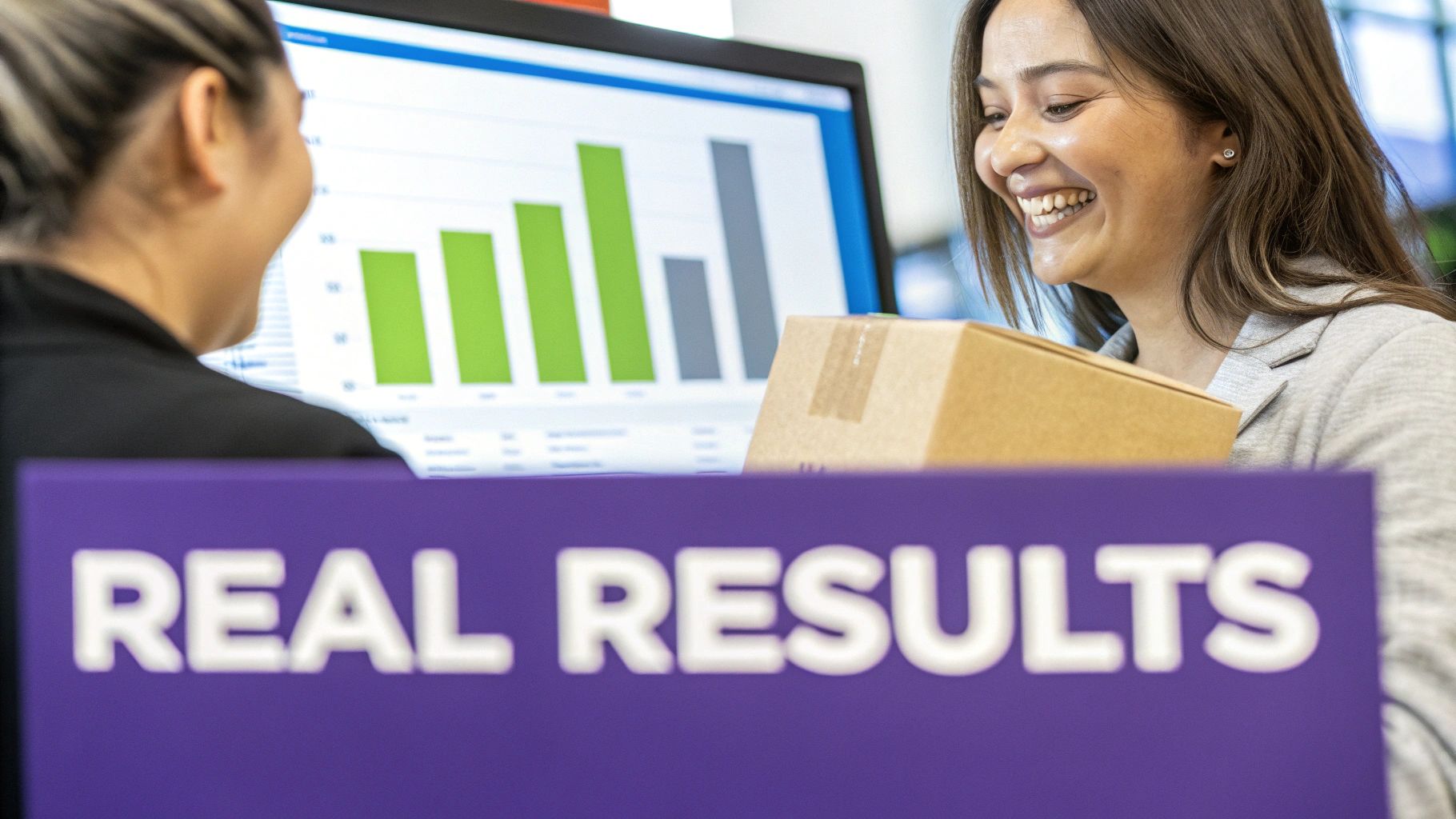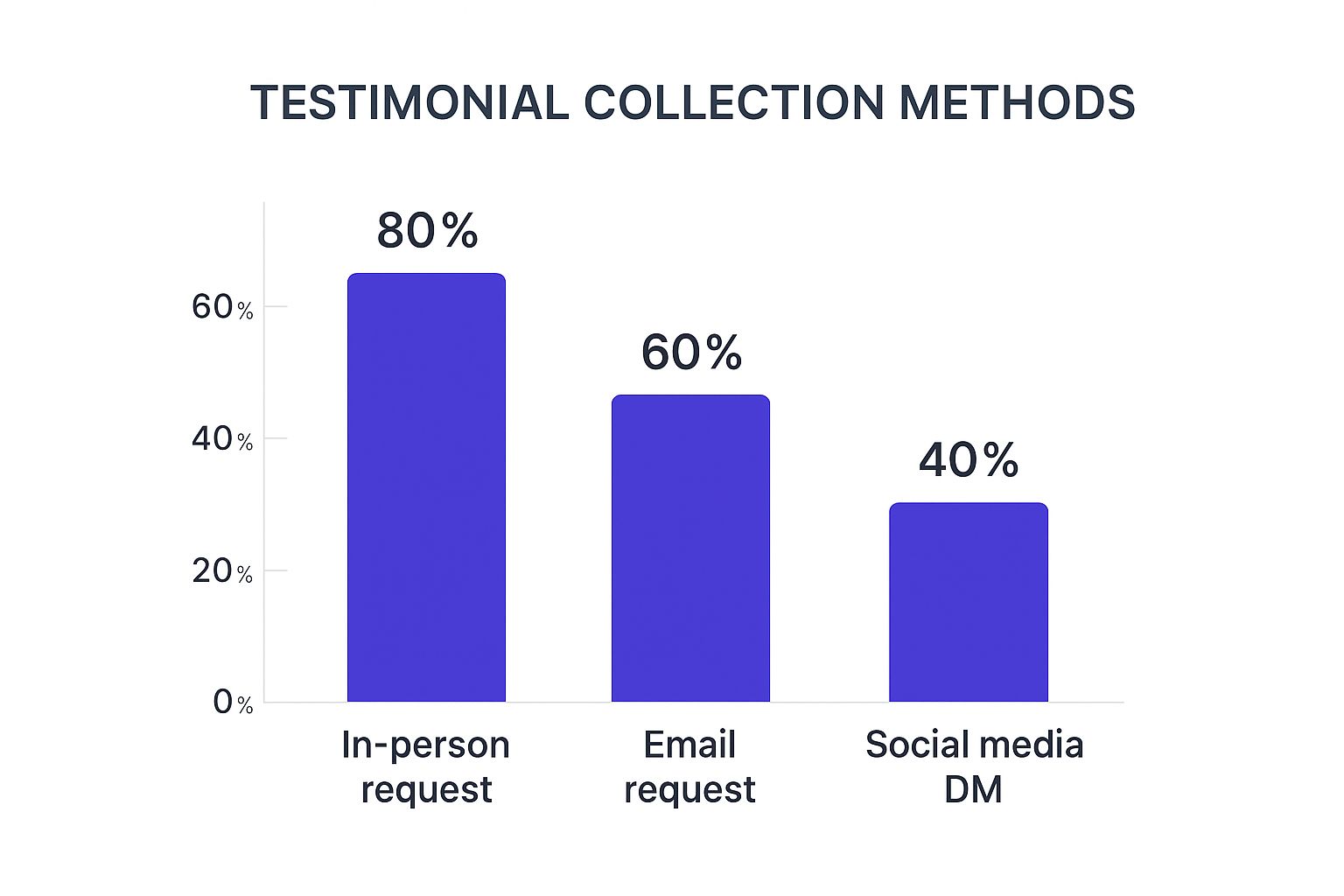What Is the Goal of a Testimonial?
Discover what is the goal of a testimonial and how real customer stories build trust, boost credibility, and drive measurable business growth.
Posted by
Let's get straight to it: the ultimate goal of a testimonial is simple but incredibly powerful. It’s all about building trust.
Your marketing claims, no matter how clever, are just words. A testimonial transforms those words into a real, human story that cuts through a potential customer's natural skepticism.
Why Testimonials Are Your Greatest Trust Signal

Picture this: you're walking down the street and see two food trucks. One has a huge, flashy sign that screams, "The Best Tacos in the World!" The other is a bit simpler, but it has a long line of people laughing and eating. You overhear someone in line say, "You have to try this; it's incredible."
Which truck are you choosing?
Almost everyone picks the second one. That’s the raw power of social proof in action, and it’s the exact reason testimonials work so well. They serve as a recommendation from a trusted friend, turning your abstract promises into something tangible and believable. A genuine story from a real customer creates an immediate emotional connection that your own marketing content just can't replicate.
The Foundation of Social Proof
At its core, social proof is a psychological shortcut. When people are unsure what to do, they look at what others are doing and assume it's the right choice. In business, this means potential buyers look to your existing customers to feel confident about their decision.
Testimonials are the most direct and potent form of this proof. The numbers don't lie: a massive 72% of consumers say positive testimonials make them trust a business more. If you want to dive deeper, we have a whole guide on how to build trust with customers.
It gets even better. A staggering 88% of consumers now trust online testimonials as much as they trust a personal recommendation from a friend or family member. Think about that for a second. The words of a happy customer they've never met carry the same weight as advice from their closest friends.
A great testimonial is more than just a five-star review—it’s a story that lets a prospect see themselves winning with your product before they even click "buy."
To really understand what testimonials can do for you, it helps to break down their goals into primary and secondary objectives.
Primary vs Secondary Goals of Testimonials
While the main goal is always trust, great testimonials deliver a whole host of other benefits that help your business grow. Here’s a quick breakdown:
| Goal Type | Objective | Business Impact |
|---|---|---|
| Primary | Build Trust and Credibility | Smashes skepticism and shortens the path to purchase. |
| Secondary | Increase Conversions | Gives people the final nudge they need at checkout. |
| Secondary | Humanize Your Brand | Creates a real, emotional connection with your audience. |
Ultimately, the primary goal—building that rock-solid foundation of trust—is what unlocks all the other benefits. When people trust you, they're far more likely to listen, engage, and ultimately, become customers themselves.
How Testimonials Build Unshakeable Credibility

Let’s be honest. When a potential customer is looking at your product, they aren't just comparing features. They're weighing risk. Will this actually fix my problem? Is it worth the price tag? That hesitation is the single biggest wall you need to break through.
Sure, your own marketing can make all the promises in the world, but a testimonial is something different. It’s powerful, third-party validation. Think of it like a trusted friend who's already taken the trip, telling you the destination is absolutely worth it.
When a new buyer hears from a real person who solved the exact problem they're facing, their sense of risk just plummets. It creates a level of confidence and security that your branded content, on its own, simply can't match.
The Power of Authentic Validation
At its core, a testimonial is just authentic proof. It shows your claims aren't just slick marketing copy—they’re backed by real-world results. That genuineness builds a layer of credibility that’s almost impossible to argue with.
This isn't just about creating a fuzzy, positive brand image. It has a direct, tangible impact on your sales. When a prospect reads a story that mirrors their own struggles and sees a happy ending, their own anxieties start to melt away.
An effective testimonial proactively addresses a customer's biggest fears and objections before they even have a chance to voice them, making the path to purchase dramatically smoother.
It’s no surprise that testimonials are consistently rated as one of the most effective types of content for sealing the deal. In fact, one recent analysis found that customer testimonials have an 89% effectiveness level—the highest of any content marketing format. It’s a stark reminder of just how much people value hearing from their peers. You can dig into more stats on the impact of testimonials on consumer decision-making.
Shortening the Sales Cycle
When you handle objections before they even come up, you fundamentally change the sales conversation. This is the key to a shorter sales cycle. Your sales team no longer has to spend all their time convincing a skeptical lead; the testimonial has already done the heavy lifting.
The benefits are immediate:
- Reduced Friction: Fewer questions and doubts mean a faster decision.
- Increased Confidence: Prospects feel more secure, so they hesitate less when it’s time to buy.
- Stronger Emotional Connection: A relatable story creates a human bond that purely logical arguments can't.
Ultimately, a well-placed testimonial delivers that final, reassuring nudge a buyer needs. It transforms their uncertainty into a confident "yes," turning them from a prospect into your next customer.
Turning Trust into Conversions and ROI

While building trust is the heart of any good testimonial, the real goal for your business is turning that trust into something you can actually measure. Think about it: a strategically placed testimonial on a product page or right at checkout can be the final push someone needs to go from "just looking" to "just bought."
These genuine stories are your secret weapon against ad fatigue. Modern buyers are experts at tuning out traditional sales pitches, but a relatable success story? That feels less like an ad and more like a helpful tip from a friend, which makes it infinitely more powerful.
The real magic of a testimonial is its ability to connect an emotional story to a logical purchasing decision. This combination is what fuels higher conversion rates and a significant return on investment (ROI).
Testimonials are also fantastic tools to overcome sales objections before they even come up. By showing how a real person solved a problem your prospect is currently facing, you dismantle their doubts and smooth out the path to purchase.
Measuring the Impact of Testimonials
The effect of testimonials on the bottom line isn't just a theory; it's backed by some pretty serious numbers. When it comes to video testimonials, for instance, research shows that 72% of marketers see ROI improvements anywhere from 50% to a staggering 500%.
And the format you choose really matters. A quick quote is perfect for social proof, but a more detailed story can be what closes a bigger deal. To get a better handle on how different formats work, our guide on customer video testimonials is a great place to start.
Ultimately, by capturing and sharing your customers' successes, you’re not just collecting nice quotes—you're building a powerful engine for growth. Each story validates what you do and becomes a hard-working asset that keeps bringing in new business long after you first publish it.
Choosing the Right Testimonial for Each Goal
Think of testimonials like a mechanic's toolkit. You wouldn't use a sledgehammer to fix a watch, right? The same logic applies here. A short, punchy quote is perfect for a homepage, but it won't have the same impact as a detailed case study for a buyer who's deep in the decision-making process.
Not all testimonials are created equal, and knowing which one to use—and when—is the key to unlocking their power.
The ultimate goal is always to build trust, but how you get there changes with the format. A long, heartfelt video story will get lost in a fast-scrolling social feed. For that, you need a quick, user-generated photo or a snappy quote to stop the scroll.
This infographic breaks down just how effective different collection methods are.

What's the big takeaway? The data shows that a personal, direct ask gets the best results. It's a clear reminder that building real relationships with your customers is what truly pays off.
Matching the Format to the Funnel Stage
To build a truly powerful library of social proof, you need a mix of different testimonial types. Each one plays a specific role in guiding a potential customer from "just looking" to "take my money."
Let's break down the most common formats and where they fit best.
- Quote Testimonials: These are your go-to for instant credibility. Think of them as short, impactful soundbites that quickly shut down any initial skepticism. They work wonders on high-traffic spots like your homepage or product pages.
- Social Media Shout-outs: Nothing screams authenticity like a raw, user-generated post. These in-the-moment snapshots of customer love are perfect for building community and trust on platforms where people crave genuine content.
- Video Stories: Want to create a real emotional connection? Use video. Putting a face and a voice to a success story makes the experience incredibly relatable and memorable, especially for prospects who are seriously weighing their options.
- In-Depth Case Studies: For the buyer who needs all the details, the case study is your heavy hitter. It’s a full-blown narrative—problem, solution, and data-backed results. This is bottom-of-the-funnel gold for convincing someone to commit.
To make this even clearer, think about how these formats line up with your marketing goals. The table below connects the dots between the type of testimonial and where it will make the biggest splash.
Matching Testimonial Type to Marketing Goal
| Testimonial Type | Primary Goal | Best Placement |
|---|---|---|
| Quote Testimonial | Build initial trust & credibility | Homepage, product pages, landing pages |
| Social Media Shout-out | Showcase authenticity & engagement | Social media feeds, website "community" sections |
| Video Story | Create an emotional connection | "About Us" page, email campaigns, key sales pages |
| In-Depth Case Study | Provide comprehensive proof & data | Dedicated "Case Studies" page, sales proposals |
Ultimately, a smart testimonial strategy isn't about collecting just one type of review. It's about building a diverse collection that speaks to different people at different stages, giving you the perfect tool for any situation.
How to Gather Powerful Testimonials
Knowing you need testimonials is one thing. Actually getting your best customers to share their stories? That's a whole different ball game. The secret isn't a mass email blast—it's about timing the ask perfectly to capture that peak moment of customer happiness.
Think about it. When are your customers most thrilled with what you do? Maybe they just finished a huge project using your tool. Or perhaps your support team swooped in and saved their day. Those are your golden opportunities. Asking for feedback right after a win like that makes an enthusiastic "yes" so much more likely. You just have to make it dead simple for them.
Making the Ask Easy
Let's be real: your customers are busy. The more hoops you make them jump through, the faster they'll abandon the request. Ditch the vague "Could you write us a testimonial?" and instead, guide them with a few specific, thought-provoking questions.
Good questions get good answers. Try these:
- What was your biggest challenge before you found us? This is all about setting the scene and defining the problem they needed to solve.
- What specific results have you seen since we started working together? This pushes them to share real, measurable outcomes—the stuff that really sells.
- What was your favorite part of the whole experience? This is where you get the gold—the emotional connection and human element of their story.
A simple form or a few clear prompts is all it takes to help them tell their story. If you're looking for more ways to approach this, we've got a whole guide on how to ask for a testimonial without it feeling awkward or pushy.
Always, always get clear, explicit permission to use their name, photo, and story in your marketing. This isn’t just about covering your legal bases; it's about respecting the relationship you’ve built.
Finally, don't be afraid to mix up the format. Getting authentic, off-the-cuff video or audio clips can be incredibly powerful. If you go that route, you’ll probably want to integrate speech-to-text into your workflow to quickly turn those spoken gems into quotes you can use anywhere.
Got Questions About Testimonials? We've Got Answers.
Running into a few questions as you start collecting customer feedback is completely normal. Let's clear up some of the most common ones so you can get started with confidence.
What’s the Real Goal of a Testimonial, Anyway?
The single most important goal of any testimonial is to build unshakable trust. Sure, they drive sales and make your marketing metrics look great, but those are just the happy side effects. The real magic happens when you establish credibility first.
Think of it this way: a testimonial is like a trust transfer. It takes the confidence a potential customer has in a peer—someone just like them—and hands it over to your brand. It’s a genuine, authentic endorsement that no amount of slick marketing copy can ever truly replicate.
How Can I Ask for a Testimonial Without Sounding Awkward or Pushy?
It’s all about timing and making it dead simple for them. The absolute best time to ask is right after a customer has a win or tells you how happy they are with your product. That's the moment.
Instead of framing it as a favor for you, position it as an opportunity for them to share their success story.
A great way to make it easy is to give them a simple form with a few guiding questions. Think things like, "What was your biggest headache before you found us?" or "What's one specific result you're proud of?" This takes the guesswork out of it and helps them tell a much better story.
Is There a "Perfect" Length for a Testimonial?
Yep, but it totally depends on where you plan to use it. There's no one-size-fits-all answer, so you have to be smart about it.
Here’s a quick way to think about it:
- Short & Punchy (1-2 sentences): These are your go-to quotes for a homepage, a social media post, or right on a product page. Their job is to grab attention and build a little bit of trust in a split second.
- Detailed Stories (A full paragraph or even a case study): Save these for a dedicated testimonials page or a sales proposal. Someone who's deep in research mode needs more than a quick quote; they're looking for real-world proof and data to help them make a final decision.
At the end of the day, just ask yourself what the goal is for that specific marketing channel. That’ll tell you exactly how long or short the testimonial needs to be.
Ready to stop awkwardly asking for reviews and start effortlessly collecting powerful video testimonials? EndorseFlow automates the whole process, turning your happiest customers into your best marketers. See how EndorseFlow can transform your social proof strategy today!